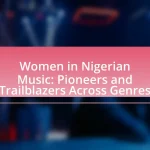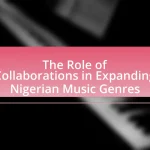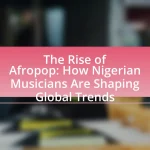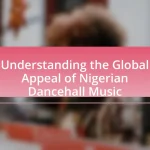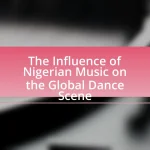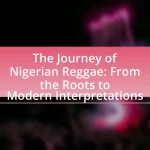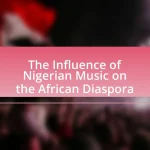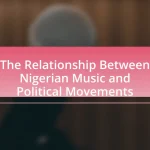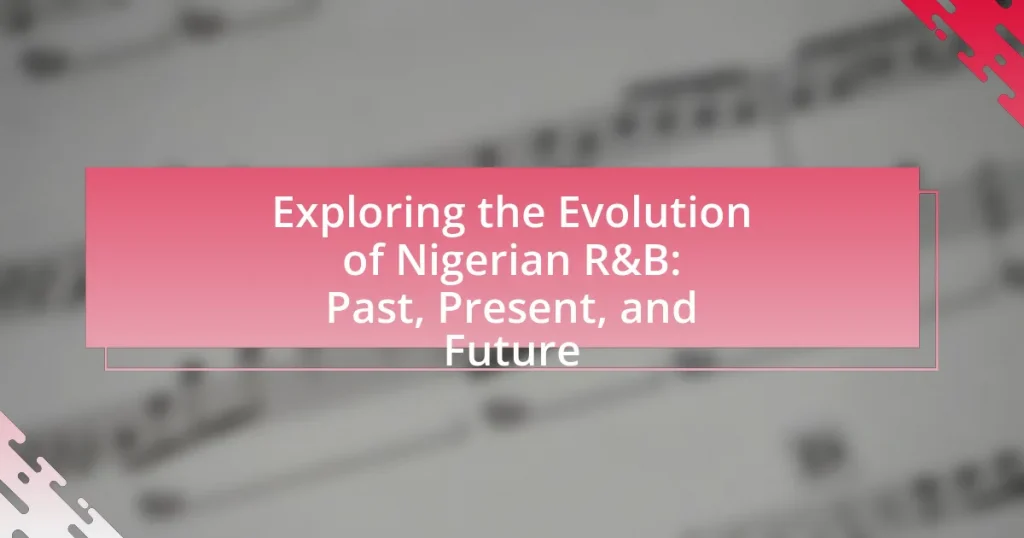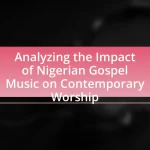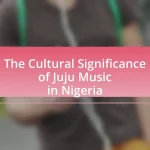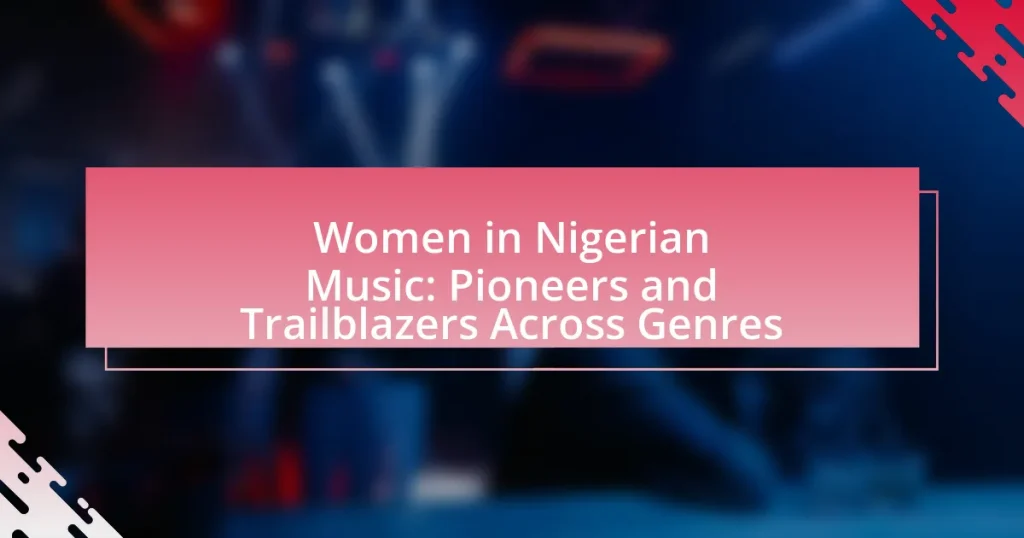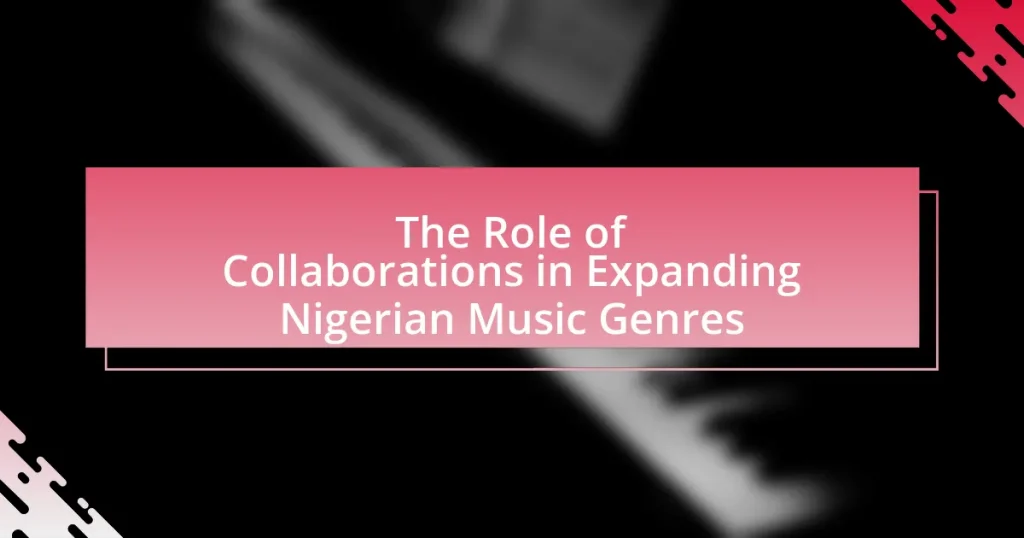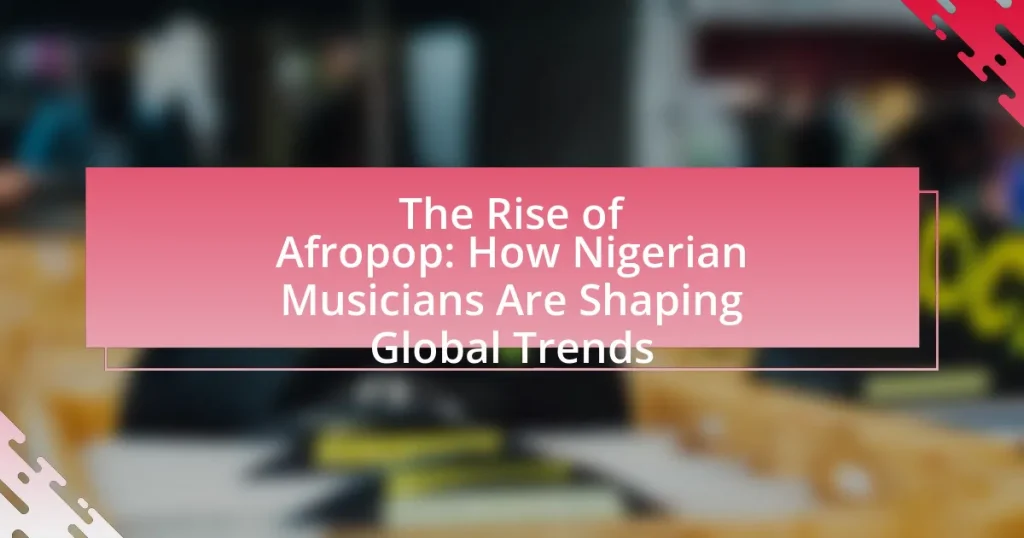The article explores the evolution of Nigerian R&B, tracing its origins from the late 1990s when it emerged as a fusion of traditional African music, hip-hop, and Western R&B influences. It highlights the contributions of pioneering artists such as 2Baba and D’banj, the genre’s growth in the 2000s with the rise of Afrobeats, and the current landscape featuring contemporary artists like Simi and Tems. Key characteristics, themes, and the impact of technology and social media on the genre’s promotion and distribution are discussed, along with the challenges faced by artists and the potential for future growth on the global stage.

What is the Evolution of Nigerian R&B?
The evolution of Nigerian R&B has progressed through distinct phases, beginning in the late 1990s with influences from American R&B and hip-hop. Early Nigerian R&B artists, such as 2Baba and D’banj, incorporated local sounds and languages, creating a unique blend that resonated with Nigerian audiences. By the 2000s, the genre gained mainstream popularity, with artists like Banky W and Wizkid further innovating the sound by integrating Afrobeats elements. The 2010s saw a surge in collaborations with international artists, enhancing the global appeal of Nigerian R&B. Today, the genre continues to evolve, characterized by diverse influences and a growing presence on international music charts, reflecting Nigeria’s rich cultural tapestry and the global music landscape.
How did Nigerian R&B originate?
Nigerian R&B originated in the late 1990s as a fusion of traditional African music, hip-hop, and Western R&B influences. This genre emerged as artists began to incorporate local languages and cultural themes into their music, creating a unique sound that resonated with Nigerian audiences. Pioneers like 2Baba and D’banj played significant roles in popularizing this genre, blending melodic vocals with contemporary beats, which helped to establish a distinct Nigerian identity within the global R&B scene. The rise of music platforms and increased access to technology further facilitated the growth of Nigerian R&B, allowing artists to reach wider audiences both locally and internationally.
What were the early influences on Nigerian R&B music?
Early influences on Nigerian R&B music include highlife, hip hop, and traditional African rhythms. Highlife, originating from Ghana, introduced melodic structures and instrumentation that shaped the sound of Nigerian R&B. The infusion of hip hop brought new lyrical styles and beats, particularly in the 1990s, as artists began to blend local sounds with global trends. Additionally, traditional African rhythms provided a cultural foundation, allowing R&B to resonate with local audiences while maintaining a contemporary appeal. These influences collectively contributed to the unique evolution of Nigerian R&B music.
Who were the pioneering artists in the Nigerian R&B scene?
The pioneering artists in the Nigerian R&B scene include artists like 2Baba (formerly known as 2Face Idibia), D’banj, and Asa. 2Baba’s debut album “Face 2 Face,” released in 2004, is often credited with popularizing R&B in Nigeria, while D’banj’s fusion of R&B with Afrobeats in hits like “Oliver Twist” helped to elevate the genre’s profile internationally. Asa, known for her soulful voice and unique style, gained recognition with her self-titled debut album in 2007, which showcased a blend of R&B, jazz, and pop influences. These artists laid the foundation for the growth and evolution of R&B in Nigeria, influencing subsequent generations of musicians.
What are the key characteristics of Nigerian R&B?
Nigerian R&B is characterized by its fusion of traditional African sounds with contemporary Western influences, creating a unique musical style. This genre often features smooth melodies, emotive lyrics, and a focus on themes of love and relationships, reflecting the cultural nuances of Nigerian society. Additionally, the use of local languages and dialects in lyrics enhances its authenticity and connection to the audience. The genre has evolved significantly since the late 1990s, with artists like D’banj and Wizkid incorporating elements of Afrobeats, hip-hop, and pop, further broadening its appeal both locally and internationally.
How does Nigerian R&B differ from other genres?
Nigerian R&B differs from other genres primarily through its unique blend of traditional African musical elements with contemporary Western influences. This genre incorporates local rhythms, indigenous languages, and cultural themes, setting it apart from Western R&B, which typically focuses on soul and pop influences. For instance, artists like Wizkid and Simi often infuse Afrobeat and highlife into their R&B tracks, creating a distinct sound that resonates with Nigerian audiences. Additionally, the lyrical content frequently addresses social issues, love, and cultural identity, reflecting the Nigerian experience, which is less common in mainstream R&B.
What themes are commonly explored in Nigerian R&B lyrics?
Common themes explored in Nigerian R&B lyrics include love, heartbreak, social issues, and cultural identity. Love is often depicted through romantic expressions and emotional connections, while heartbreak addresses the pain of lost relationships. Social issues such as poverty, inequality, and political struggles are also prevalent, reflecting the realities of life in Nigeria. Additionally, cultural identity themes celebrate Nigerian heritage and experiences, often incorporating local languages and traditions. These themes resonate with listeners, making Nigerian R&B relatable and impactful.
How has Nigerian R&B evolved over the decades?
Nigerian R&B has evolved significantly over the decades, transitioning from its early influences of highlife and traditional music to a contemporary sound that incorporates elements of hip-hop, pop, and Afrobeats. In the 1990s, artists like Onyeka Onwenu and 2Baba began to popularize the genre, blending soulful melodies with local rhythms. By the 2000s, the emergence of artists such as D’banj and Banky W further transformed Nigerian R&B, introducing a fusion of Western styles and local sounds, which appealed to a broader audience. The 2010s saw the rise of new talents like Simi and Adekunle Gold, who continued to innovate by integrating storytelling and personal experiences into their music, reflecting societal changes. This evolution is marked by a growing international presence, with Nigerian R&B artists collaborating with global stars and gaining recognition on platforms like Spotify and Apple Music, showcasing the genre’s dynamic growth and cultural significance.
What significant changes occurred in the 1990s?
The 1990s saw significant changes in Nigerian R&B, marked by the emergence of new artists and the fusion of traditional African sounds with contemporary music styles. This decade introduced influential figures such as 2Baba and D’banj, who helped popularize the genre and broaden its appeal. The rise of music videos and the proliferation of radio stations contributed to the visibility of R&B, allowing artists to reach wider audiences. Additionally, the establishment of record labels and the growth of the Nigerian music industry facilitated the production and distribution of R&B music, leading to a vibrant and evolving musical landscape.
How did the 2000s shape the sound of Nigerian R&B?
The 2000s significantly shaped the sound of Nigerian R&B by introducing a fusion of traditional African rhythms with contemporary Western influences, particularly hip-hop and soul. This era saw the emergence of artists like 2Baba and D’banj, who incorporated local dialects and themes into their music, creating a unique sound that resonated with both local and international audiences. The rise of digital production techniques and the proliferation of music videos on platforms like MTV Base further popularized the genre, allowing for greater visibility and accessibility. Consequently, Nigerian R&B evolved into a distinct genre characterized by melodic hooks, emotive lyrics, and a blend of various musical styles, establishing a foundation for future artists in the genre.

What is the Current State of Nigerian R&B?
The current state of Nigerian R&B is characterized by a vibrant fusion of traditional sounds and contemporary influences, with artists like Simi, Adekunle Gold, and Tems leading the genre’s evolution. This genre has gained significant popularity, evidenced by the increasing number of collaborations with international artists and the rise of streaming platforms that showcase Nigerian talent globally. The Nigerian R&B scene is also marked by a growing emphasis on lyrical depth and emotional storytelling, reflecting societal issues and personal experiences, which resonates with a diverse audience.
Who are the leading contemporary Nigerian R&B artists?
The leading contemporary Nigerian R&B artists include Wizkid, Simi, and Tems. Wizkid, known for his fusion of R&B with Afrobeats, has gained international acclaim, particularly with his album “Made in Lagos.” Simi, recognized for her soulful voice and relatable lyrics, has made significant contributions to the genre with hits like “Duduke.” Tems has emerged as a powerful voice in R&B, gaining global recognition through collaborations and her unique sound, highlighted in her EP “For Broken Ears.” These artists exemplify the current landscape of Nigerian R&B, showcasing its evolution and growing influence.
What styles and influences are prominent in their music?
Nigerian R&B prominently features styles such as Afrobeats, hip-hop, and traditional African music. These influences shape its rhythmic and melodic structures, creating a unique sound that resonates with both local and international audiences. The integration of Afrobeats brings vibrant percussion and danceable grooves, while hip-hop contributes lyrical complexity and storytelling elements. Traditional African music infuses cultural authenticity, often incorporating indigenous instruments and vocal techniques. This blend reflects the genre’s evolution and its ability to adapt to contemporary trends while maintaining its roots.
How do these artists engage with their audience?
Nigerian R&B artists engage with their audience through social media interaction, live performances, and relatable lyrical content. These artists utilize platforms like Instagram and Twitter to connect directly with fans, sharing personal stories and behind-the-scenes content that fosters a sense of community. Additionally, live performances allow for real-time engagement, where artists can respond to audience reactions and create memorable experiences. The lyrics often reflect everyday experiences and emotions, making the music relatable and resonant with listeners, which enhances audience connection and loyalty.
What role does technology play in the production of Nigerian R&B today?
Technology plays a crucial role in the production of Nigerian R&B today by enabling artists to create, distribute, and promote their music more efficiently. Digital audio workstations (DAWs) allow producers to craft high-quality soundscapes from anywhere, facilitating collaboration across distances. The rise of streaming platforms like Spotify and Apple Music has transformed how music is consumed, providing artists with global reach and real-time analytics on listener engagement. Additionally, social media platforms serve as vital marketing tools, allowing artists to connect directly with fans and promote their work without traditional gatekeepers. This technological integration has led to a more dynamic and accessible music industry in Nigeria, fostering innovation and diversity in the R&B genre.
How has social media impacted the promotion of Nigerian R&B artists?
Social media has significantly enhanced the promotion of Nigerian R&B artists by providing them with direct access to a global audience. Platforms like Instagram, Twitter, and TikTok allow artists to share their music, engage with fans, and build their brand without relying solely on traditional media outlets. For instance, Nigerian R&B artist Simi gained widespread recognition through her active social media presence, where she showcased her music and connected with listeners, leading to millions of streams on platforms like Spotify and Apple Music. Additionally, social media facilitates viral marketing; songs can quickly gain traction through user-generated content, as seen with the viral success of Joeboy’s “Baby,” which was propelled by TikTok challenges. This direct engagement and the ability to create viral moments have transformed how Nigerian R&B artists promote their work, making social media an essential tool in their marketing strategies.
What are the current trends in music distribution for Nigerian R&B?
Current trends in music distribution for Nigerian R&B include the rise of digital streaming platforms, social media promotion, and independent distribution channels. Digital streaming services like Spotify and Apple Music have become primary avenues for artists to reach audiences, with a significant increase in user engagement in Nigeria, where streaming subscriptions grew by over 30% in 2022. Social media platforms, particularly Instagram and TikTok, are utilized for marketing and audience engagement, allowing artists to promote their music directly to fans. Additionally, independent distribution services such as DistroKid and TuneCore enable artists to release their music without traditional label constraints, fostering a more diverse and accessible music landscape. These trends reflect a shift towards digital-first strategies in the Nigerian R&B scene, aligning with global music consumption patterns.
What challenges does the Nigerian R&B industry face today?
The Nigerian R&B industry faces significant challenges today, including limited funding, inadequate infrastructure, and intense competition from other music genres. Limited funding restricts artists’ ability to produce high-quality music and promote their work effectively. Inadequate infrastructure, such as poor recording facilities and lack of distribution channels, hampers the growth and reach of R&B artists. Additionally, the rise of Afrobeats and other popular genres creates fierce competition, making it difficult for R&B to maintain its audience and market share. These factors collectively hinder the development and sustainability of the Nigerian R&B scene.
How do economic factors affect the growth of Nigerian R&B?
Economic factors significantly influence the growth of Nigerian R&B by affecting production budgets, artist revenues, and market accessibility. The Nigerian economy, characterized by fluctuating oil prices and inflation, impacts disposable income, which in turn affects consumer spending on music and entertainment. For instance, during economic downturns, consumers may prioritize essential goods over entertainment, leading to reduced sales for R&B artists. Additionally, the availability of funding and investment in the music industry is often tied to economic stability; when the economy is strong, there are more opportunities for sponsorships and collaborations, which can enhance the visibility and reach of R&B artists. Furthermore, the rise of digital platforms has provided a cost-effective means for artists to distribute their music, but the overall economic environment still dictates the level of investment in marketing and promotion, ultimately shaping the growth trajectory of the genre in Nigeria.
What barriers do artists encounter in the music industry?
Artists encounter several barriers in the music industry, including financial constraints, lack of access to distribution channels, and limited exposure to audiences. Financial constraints often hinder artists from producing high-quality music and marketing their work effectively, as many rely on personal funds or small-scale investments. Additionally, the lack of access to distribution channels restricts their ability to reach wider audiences, as traditional record labels may prioritize established artists over emerging talent. Limited exposure is further exacerbated by the dominance of mainstream genres in media, making it challenging for artists in niche genres, such as Nigerian R&B, to gain recognition. These barriers collectively impede the growth and sustainability of artists within the competitive landscape of the music industry.

What is the Future of Nigerian R&B?
The future of Nigerian R&B is poised for significant growth and innovation, driven by the genre’s increasing popularity both locally and internationally. As artists like Simi, Tems, and Omah Lay gain global recognition, they are expanding the reach of Nigerian R&B, blending traditional sounds with contemporary influences. The rise of digital platforms such as Spotify and Apple Music facilitates wider distribution, allowing Nigerian R&B artists to connect with a global audience. Additionally, collaborations with international artists are likely to enhance the genre’s appeal, further solidifying its place in the global music landscape.
How is the next generation of artists shaping Nigerian R&B?
The next generation of artists is shaping Nigerian R&B by infusing contemporary sounds and global influences into traditional music styles. This evolution is evident in the works of artists like Tems and Omah Lay, who blend Afrobeat rhythms with R&B melodies, creating a unique sound that resonates with both local and international audiences. Their collaborations with global artists and incorporation of diverse genres, such as hip-hop and pop, further expand the reach and appeal of Nigerian R&B. This shift is supported by the rise of digital platforms, which allow these artists to share their music widely, leading to increased visibility and a growing fanbase.
What new sounds and influences are emerging in the genre?
New sounds and influences emerging in Nigerian R&B include the integration of Afrobeats, trap, and electronic music elements. This fusion reflects the genre’s evolution as artists like Tems and Santi incorporate diverse rhythms and production techniques, enhancing the traditional R&B sound. The rise of digital platforms has facilitated global collaborations, allowing Nigerian artists to blend local styles with international influences, further enriching the genre’s sonic landscape.
How are collaborations influencing the future of Nigerian R&B?
Collaborations are significantly shaping the future of Nigerian R&B by fostering genre fusion and expanding audience reach. Notable partnerships between R&B artists and musicians from genres like Afrobeats and hip-hop have led to innovative sounds that attract diverse listeners. For instance, the collaboration between Simi and Adekunle Gold produced a blend of R&B and Afrobeats that resonated widely, showcasing how cross-genre partnerships can enhance musical creativity and commercial success. Additionally, collaborations often leverage the fan bases of each artist, increasing visibility and promoting the genre on both local and international platforms. This trend is evidenced by the rising number of collaborative projects in recent years, indicating a shift towards a more interconnected music scene in Nigeria.
What potential does Nigerian R&B have on the global stage?
Nigerian R&B has significant potential on the global stage due to its unique blend of traditional African sounds and contemporary music styles. This genre has gained international recognition, exemplified by artists like Wizkid and Tems, who have collaborated with global stars and achieved chart success. The rise of streaming platforms has facilitated the global reach of Nigerian R&B, allowing it to penetrate markets in Europe, North America, and beyond. Additionally, the increasing interest in African music, as evidenced by the growing number of African music festivals and awards, further underscores the genre’s potential to influence global music trends.
How can Nigerian R&B artists expand their reach internationally?
Nigerian R&B artists can expand their reach internationally by leveraging digital platforms for global distribution and collaboration. Utilizing streaming services like Spotify and Apple Music allows artists to access international audiences, as these platforms have millions of users worldwide. Collaborations with established international artists can also enhance visibility; for instance, Nigerian artist Wizkid gained global recognition through his collaboration with Drake on “One Dance.” Additionally, engaging in social media marketing and participating in international music festivals can further increase their exposure. According to a report by the International Federation of the Phonographic Industry (IFPI), digital music consumption has surged, indicating a growing opportunity for artists to reach global listeners.
What role does cultural exchange play in the evolution of Nigerian R&B?
Cultural exchange significantly influences the evolution of Nigerian R&B by integrating diverse musical styles and elements from various cultures. This genre has absorbed influences from American R&B, hip-hop, and Afrobeat, leading to a unique sound that resonates with both local and international audiences. For instance, artists like Wizkid and Burna Boy incorporate Western production techniques and lyrical themes while maintaining African rhythms and languages, showcasing this blend. The collaboration between Nigerian artists and international musicians further exemplifies this exchange, as seen in projects that feature cross-continental partnerships, enhancing the genre’s global appeal and innovation.
What practical steps can aspiring artists take to succeed in Nigerian R&B?
Aspiring artists can succeed in Nigerian R&B by focusing on building a strong personal brand, creating high-quality music, and leveraging social media for promotion. Establishing a unique identity helps artists stand out in a competitive market, while producing well-crafted songs enhances their appeal to listeners. Additionally, utilizing platforms like Instagram, TikTok, and YouTube allows artists to reach a broader audience and engage with fans directly.
For instance, artists like Burna Boy and Tems have effectively used social media to showcase their music and connect with fans, contributing to their international success. Furthermore, collaborating with established artists can provide exposure and credibility, as seen with many rising stars in the genre. By following these steps, aspiring artists can navigate the Nigerian R&B landscape more effectively.
What resources are available for new artists in the industry?
New artists in the Nigerian R&B industry can access various resources, including music distribution platforms, social media for promotion, and mentorship programs. Music distribution platforms like DistroKid and TuneCore allow artists to release their music on major streaming services, increasing visibility. Social media platforms such as Instagram and TikTok provide avenues for marketing and audience engagement, essential for building a fan base. Additionally, organizations like the Music Business Academy offer mentorship programs that connect emerging artists with industry professionals, enhancing their skills and industry knowledge. These resources collectively support new artists in navigating the competitive landscape of the music industry.
How can artists effectively market their music in today’s landscape?
Artists can effectively market their music in today’s landscape by leveraging digital platforms and social media to reach their audience. Utilizing platforms like Spotify, Apple Music, and YouTube allows artists to distribute their music widely, while social media channels such as Instagram, TikTok, and Twitter enable direct engagement with fans. According to a 2021 report by the International Federation of the Phonographic Industry, over 70% of music consumption now occurs through streaming services, highlighting the importance of these platforms for visibility. Additionally, artists can collaborate with influencers and other musicians to expand their reach, as collaborations often lead to cross-promotion and access to new fan bases.
